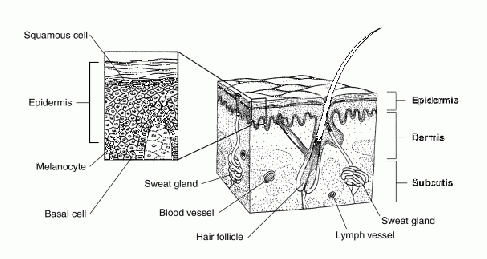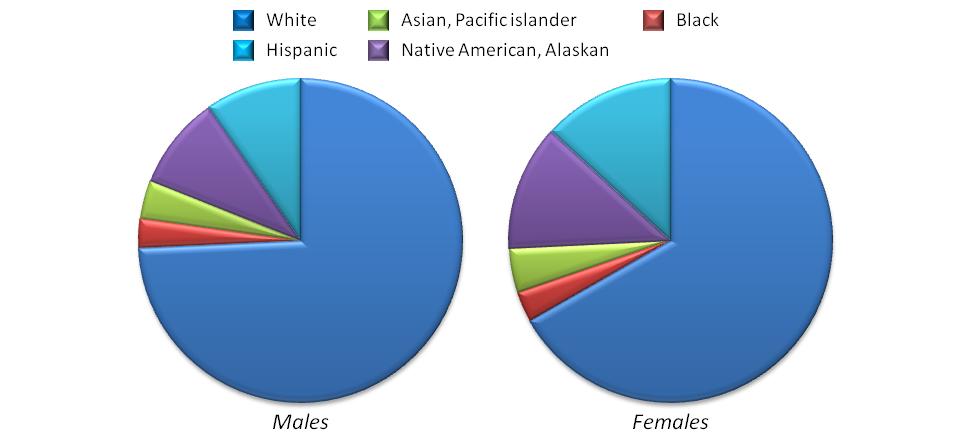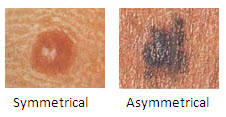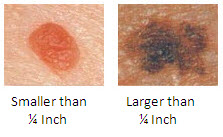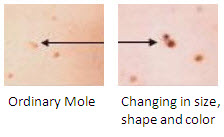Malignant Melanoma
Original Editors - Emily Erwin & Brooke Sowards from Bellarmine University's Pathophysiology of Complex Patient Problems project.
Top Contributors - Emily Erwin, Brooke Sowards, Ellen Hosking, Lucinda hampton, Elaine Lonnemann, Vidya Acharya, Kim Jackson, 127.0.0.1, Wendy Walker, Calli Paydo and WikiSysop
Definition/Description[edit | edit source]
Malignant Melanoma is a cancer that begins in a specific type of skin cells known as melanocytes. This type of cancer may also be known as melanoma or cutaneous melanoma.
Melanocytes are located in the most superficial layer of skin, the epidermis. The epidermis protects the underlying dermis and subcutaneous tissue layers of the skin. Melanocytes are found in the basal layer, or the lowest layer, of the epidermis. These cells produce a brown pigment known as melanin, which gives the skin its tan appearance. After sun exposure, additional melanin is produced, resulting in a darkening or "tanning" of the skin. Melanin also plays an integral role in preventing skin damage from the sun's harmful rays. [1]
Malignant growths may occur following damage to skin cell DNA. If unrepaired, this damage initiates mutations that result in rapid proliferation of skin cells that form malignant tumors. [2]
Prevalence/Risk Factors
[edit | edit source]
Although Malignant Melanoma accounts for less than 2% of total skin cancer cases, it causes a much larger percentage of skin cancer deaths. The American Cancer Society predicts for melanoma in the United States for 2014:
- Approximately 76,100 new melanomas will be diagnosed (43,890 in men and 32,210 in women)[1]
- Aproximately 9,710 people are expected to die of melanoma (6,470 men and 3,240 women)[1]
Overall, melanoma is more common in men than women. However, before the age of 40 the risk is higher for women and after the age of 40 the risk is higher for men. Although it is more likely to occur in the older population, it is one of the most common cancers in young individuals, particularly women under the age 30. The incidence of new cases is higher among whites than any other racial/ethnic group. [3] Whites with light hair color, blue or green eyes, or fair skin that easily burns are at an increased risk. [1]
An individual’s risk of developing melanoma is also greater if an immediate relatives such as a parent, brother, sister, or child, has had melanoma. Around 10% of all people with melanoma report a positive family history of the disease. This increased risk could be associated with a similar lifestyle of frequent sun exposure, a common characteristic of fair skin, or a combination of factors. It may also be caused by gene mutations that are hereditary. In families that have a high rate of melanoma, up to 40% have a known gene mutation. [1]
Another major risk factor for developing melanoma is the excessive exposure to UV radiation through sunlight and tanning booths. There are three types of UV rays; UVA, UVB, UVC. UVA and UVB, which are found in sunlight and tanning booths, cause damage to skin cell DNA which promotes the development of melanoma. UVC rays are not found in sunlight therefore are not damaging or associated with melanoma. [4]
Characteristics/Clinical Presentation[edit | edit source]
The most common early indication of malignant melanoma is often the presence of an abnormal mole. There are five specific characteristics that can help you identify whether a mole is cancerous or not. Health care professionals may educate patients on the “ABCDE” warning signs of melanoma. Research with digital imaging has confirmed that the ABCDE warning signs have a sensitivity ranging from 57% to 90% and a specificity from 59% to 90%.[5]
A = Asymmetry; uneven edges, lopsided in shape, one half unlike the other half. If you draw a line through the asymmetrical mole, the two halves will not match. [2][5]
B = Border; irregularity, irregular edges, scalloped, notched, or poorly defined edges[2][5]
C = Color; black, shades of brown, red, white, occasionally blue. Having multiple colors present is also an abnormal finding.[2][5]
D = Diameter; larger than a pencil eraser (1/4 in or 6 mm)[2][5]
E = Evolving; mole or skin lesion that looks different from the rest, or is changing in size, shape, or color. Other changes, such as bleeding, itching, or crusting, may also occur.[2][5]
Associated Comorbidities
[edit | edit source]
Individuals who have been diagnosed with dysplastic nevus syndrome often develop malignant melanoma later in life. This syndrome, also known as atypical mole syndrome, is a familial disorder that results in a significant number of large moles that have an irregular shape or color. They frequently appear on skin that is exposed to the sun but can develop anywhere on the body. The dysplastic nevi have up to a 50% chance of developing into malignant melanoma; therefore, they are often surgically removed to prevent cancer. Individuals with this syndrome are encouraged to have routine skin exams by a dermatologist and should preform monthly self skin exams. [4][1]
Interaction between melanoma and comorbidity was primarily concentrated between patients with distant metastases which raised the possibility that comorbiditity is associated with delay of melanoma dx, advanced cancer stage, and less aggressive melanoma treatment. Increased attent to optimizing treatment of comorbid diseases in the first year may reduce the mortality rate. MI,CHF,PVD,CVD,dementia, pulmonary disease, liver disease, DM, AIDS
Medications[edit | edit source]
add text here
Diagnostic Tests/Lab Tests/Lab Values[edit | edit source]
add text here
Etiology/Causes[edit | edit source]
add text here
Systemic Involvement[edit | edit source]
add text here
Medical Management (current best evidence)[edit | edit source]
add text here
Physical Therapy Management (current best evidence)[edit | edit source]
add text here
Alternative/Holistic Management (current best evidence)[edit | edit source]
add text here
Differential Diagnosis[edit | edit source]
add text here
Case Reports/ Case Studies[edit | edit source]
add links to case studies here (case studies should be added on new pages using the case study template)
Resources
[edit | edit source]
add appropriate resources here
Recent Related Research (from Pubmed)[edit | edit source]
see tutorial on Adding PubMed Feed
Extension:RSS -- Error: Not a valid URL: addfeedhere|charset=UTF-8|short|max=10
References[edit | edit source]
see adding references tutorial.
- ↑ 1.0 1.1 1.2 1.3 1.4 1.5 Melanoma Skin Cancer. American Cancer Society. Available at http://www.cancer.org/cancer/skincancer-melanoma/index. Accessed March 17, 2014.
- ↑ 2.0 2.1 2.2 2.3 2.4 2.5 Melanoma. Skin Cancer Foundation. Available at http://www.skincancer.org/skin-cancer-information/melanoma. Accessed March 17, 2014.
- ↑ SEER Stat Fact Sheets: Melanoma of the Skin. National Cancer Institute. Available at: http://seer.cancer.gov/statfacts/html/melan.html. Accessed: March 17, 2014
- ↑ 4.0 4.1 Goodman C, Fuller K. The Integumentary System. In: Pathology Implications for the Physical Therapist. 3rd ed. St. Louis, MO: Saunders Elsevier; 2009: 392-452.
- ↑ 5.0 5.1 5.2 5.3 5.4 5.5 Goodman CC, Snyder TE. Screening for Cancer. In: Differential Diagnosis for Physical Therapists, Screening for Referral. W B Saunders Company; 2012: 487-543.
